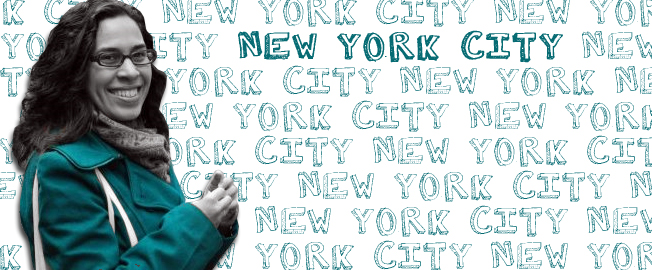
Janet Biggs’s “Airs Above the Ground” is one of the many highlights of the free inaugural Moving Image art fair (image courtesy Janet Biggs)
Waterfront New York Tunnel
269 11th Ave. between 27th & 28th Sts.
March 3-6, free
212-643-3152
www.moving-image.info
We consider ourselves “vide-hos” — we rarely meet an experimental video that doesn’t intrigue us in one way or another. So we’re excited about the inaugural Moving Image art fair, an invitational show consisting of single-channel videos, video sculptures, and video installations. Held in the Waterfront Tunnel on the far northwest side of Chelsea during Armory Arts Week, the four-day fair is the brainchild of Winkleman Gallery’s Edward Winkleman and Murat Orozobekov and has been organized by P·P·O·W Gallery’s Penny Pilkington and Wendy Olsoff, with an advisory committee made up of Zoe Butt of Ho Chi Minh City’s SanArt, John Connelly of New York’s Felix Gonzalez-Torres Foundation, Elizabeth Dee of Chelsea’s Elizabeth Dee Gallery, Raphael Gygax of Zurich’s Migros Museum, and Kevin McGarry of LA’s Migrating Forms. Video-based works from approximately three dozen international artists are being shown, including Shana Moulton, Genesis Breyer P-Orridge, Glenn Fogel, Miguel Angel Rios, Amparo Sard, Carolee Schneeman, Martin Solo Climent, and Leslie Thornton, ranging from one minute (Johanna Unzuta’s hypnotic “Natural Movements”) to thirty-three (Simon Gush’s soccer-as-political-metaphor “In the Company Of”). The majority of the works are shown on individual flat-screen monitors suspended from above and lined up along each side of the vertical passageway, some with chairs and headphones. When you first enter the Waterfront New York Tunnel, on your left will be Kasmalieva and Djumaliev’s “Trans Siberian Amazons,” featuring three video sets embedded within plaid Chinese bags filled with clothing. It’s okay to step on Cal Thompson’s floor video, “The Orb,” on your way to such wonderful special installations as Michal Rovner’s brilliant “June,” Jim Campbell’s light sculpture “Exploded View,” and Corban Walker’s “TV Man,” in which the diminutive artist (actual size) looks out calmly while seemingly trapped in a video booth.
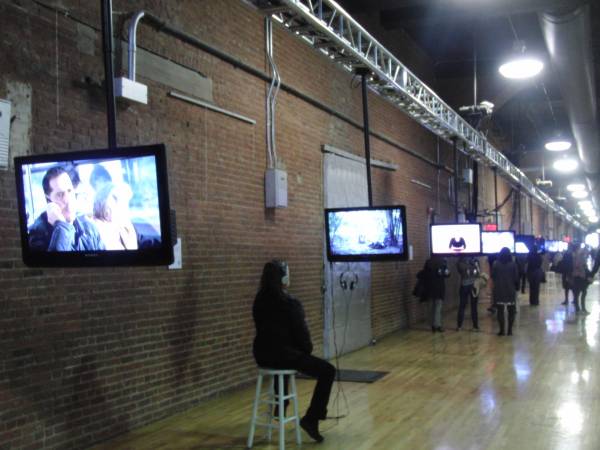
Flat-screen video monitors line both sides of the Waterfront New York Tunnel in Chelsea at the Moving Image art fair (twi-ny/mdr)
There are a number of other outstanding works, and not only from such late legends as David Wojnarowicz (“Heroin”) and Hannah Wilke (“Intercourse with . . .”). In “Alive — An Essential Guide to Survival,” Cecilia Stenbom spends nearly fifteen minutes sitting at a table reading a playful modern-day guide on how to defeat such constant threats as germs, terrorist attacks, and eating out in restaurants. Made in 2002 when he was a graduate student in London, Hiraki Sawa’s “Dwelling” turns his dorm room into airspace for plane activity, with flights taking off from tables and carpeting and flying through hallways and bathrooms. Janet Biggs’s “Airs Above the Ground” follows a synchronized swimmer as she first prepares to get in the water, then delves into her aquatic training. In “Danse Serpentine (Doubled and Refracted),” Miranda Lichtenstein transforms the Lumières’ classic 1896 film of Loie Fuller into an intoxicating endless loop. On Saturday at 2:00, a spotlight panel will examine “Current Takes on Video,” with artists Leslie Thornton and Lucy Raven and curators Chrissie Iles, Barbara London, and Glenn Phillips, moderated by McGarry. As an added bonus, admission to the fair and the panel is free. Moving Image has made an impressive debut that we hope keeps it coming back year after year after year.
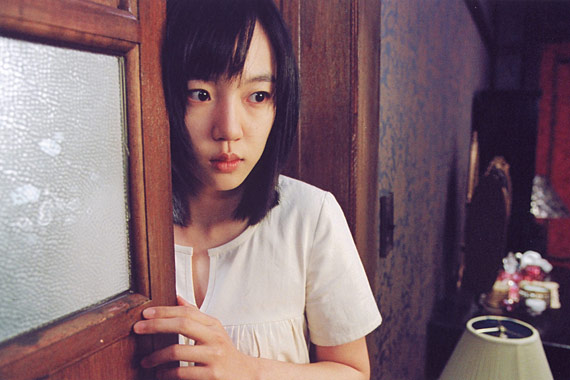
 Returning home after having been hospitalized for mental reasons, sisters Su-mi (Im Su-jeong) and Su-yeon (Moon Geun Young) find their house very different — in addition to their father (Kim Kap-su) and his second wife, Eun-joo (Yeom Jeong-ah), there appears to be an unexplained presence that seems particularly interested in the extremely vulnerable Su-yeon. As tensions mount between the girls and the wicked stepmother, more and more blood shows up, as well as far too many confusing twists and turns. Though there is a lot to admire in this gripping psychological thriller, you’ll be scratching your head at the end, wondering just what the heck you have just seen. An Asian mix of The Sixth Sense (M. Night Shyamalan, 1999), Sisters (Brian DePalma, 1973), and the Cinderella fairy tale, Kim Jee-woon’s film has plenty of creeps that unfortunately never come together. Still, it was recently remade by Hollywood as The Uninvited, directed by Charles and Thomas Guard and starring David Strathairn and Elizabeth Banks.
Returning home after having been hospitalized for mental reasons, sisters Su-mi (Im Su-jeong) and Su-yeon (Moon Geun Young) find their house very different — in addition to their father (Kim Kap-su) and his second wife, Eun-joo (Yeom Jeong-ah), there appears to be an unexplained presence that seems particularly interested in the extremely vulnerable Su-yeon. As tensions mount between the girls and the wicked stepmother, more and more blood shows up, as well as far too many confusing twists and turns. Though there is a lot to admire in this gripping psychological thriller, you’ll be scratching your head at the end, wondering just what the heck you have just seen. An Asian mix of The Sixth Sense (M. Night Shyamalan, 1999), Sisters (Brian DePalma, 1973), and the Cinderella fairy tale, Kim Jee-woon’s film has plenty of creeps that unfortunately never come together. Still, it was recently remade by Hollywood as The Uninvited, directed by Charles and Thomas Guard and starring David Strathairn and Elizabeth Banks.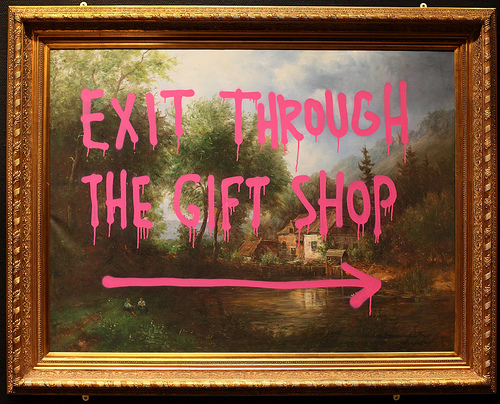
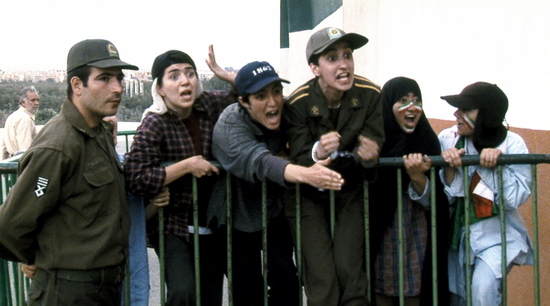
 Filmed on location in and around Tehran’s Azadi Stadium and featuring a talented cast of nonprofessional actors, Jafar Panahi’s Offside is a brilliant look at gender disparity in modern-day Iran. Although it is illegal for girls to go to soccer games in Iran — because, among other reasons, the government does not think it’s appropriate for females to be in the company of screaming men who might be cursing and saying other nasty things — many try to get in, facing arrest if they get caught. Offside is set during an actual match between Iran and Bahrain; a win will put Iran in the 2006 World Cup. High up in the stadium, a small group of girls, dressed in various types of disguises, have been captured and are cordoned off, guarded closely by some soldiers who would rather be watching the match themselves or back home tending to their sheep. The girls, who can hear the crowd noise, beg for one of the men to narrate the game for them. Meanwhile, an old man is desperately trying to find his daughter to save her from some very real punishment that her brothers would dish out to her for shaming them by trying to get into the stadium. Despite its timely and poignant subject matter, Offside is a very funny film, with fine performances by Sima Mobarak Shahi, Shayesteh Irani, Ida Sadeghi, Golnaz Farmani, Mahnaz Zabihi, and Nazanin Sedighzadeh as the girls and M. Kheymeh Kabood as one of the soldiers.
Filmed on location in and around Tehran’s Azadi Stadium and featuring a talented cast of nonprofessional actors, Jafar Panahi’s Offside is a brilliant look at gender disparity in modern-day Iran. Although it is illegal for girls to go to soccer games in Iran — because, among other reasons, the government does not think it’s appropriate for females to be in the company of screaming men who might be cursing and saying other nasty things — many try to get in, facing arrest if they get caught. Offside is set during an actual match between Iran and Bahrain; a win will put Iran in the 2006 World Cup. High up in the stadium, a small group of girls, dressed in various types of disguises, have been captured and are cordoned off, guarded closely by some soldiers who would rather be watching the match themselves or back home tending to their sheep. The girls, who can hear the crowd noise, beg for one of the men to narrate the game for them. Meanwhile, an old man is desperately trying to find his daughter to save her from some very real punishment that her brothers would dish out to her for shaming them by trying to get into the stadium. Despite its timely and poignant subject matter, Offside is a very funny film, with fine performances by Sima Mobarak Shahi, Shayesteh Irani, Ida Sadeghi, Golnaz Farmani, Mahnaz Zabihi, and Nazanin Sedighzadeh as the girls and M. Kheymeh Kabood as one of the soldiers.
 One of the craziest movies ever made, Nobuhiko Obayashi’s 1977 cult classic, HOUSE (HAUSU), is finally getting its first-ever U.S. theatrical release, in a new 35mm print at the IFC Center. Truly one of those things that has to be seen to be believed, HOUSE is a psychedelic black horror comedy musical about Gorgeous (Kimiko Ikegami) and six of her high school friends who choose to spend part of their summer vacation at Gorgeous’s aunt’s (Yoko Minamida) very strange house. Gorgeous, whose mother died when she was little and whose father (Saho Sasazawa) is about to get married to Ryoko (Haruko Wanibuchi), brings along her playful friends Melody (Eriko Ikegami), Fantasy (Kumiko Oba), Prof (Ai Matsubara), Sweet (Masayo Miyako), Kung Fu (Miki Jinbo), and Mac (Mieko Sato), who quickly start disappearing like ten little Indians. HOUSE is a ceaselessly entertaining head trip of a movie, a tongue-in-chic celebration of genre with spectacular set designs by Kazuo Satsuya, beautiful cinematography by Yoshitaka Sakamoto, and a fab score by Asei Kobayashi and Mickie Yoshino. The original story actually came from the mind of Obayashi’s eleven-year-old daughter, Chigumi, who clearly has one heck of an imagination. Oh, and we can’t forget about the evil cat, a demonic feline to end all demonic felines. The film was released last year prior to its appearance on DVD from Janus, the same company that puts out such classic fare as Federico Fellini’s AMARCORD, Akira Kurosawa’s RASHOMON, Jacques Tati’s M. HULOT’S HOLIDAY, François Truffaut’s SHOOT THE PIANO PLAYER, Jean Renoir’s THE RULES OF THE GAME, and Jean-Luc Godard’s VIVRE SA VIE, so HOUSE has joined some very prestigious company. And who are we to say it doesn’t deserve it?
One of the craziest movies ever made, Nobuhiko Obayashi’s 1977 cult classic, HOUSE (HAUSU), is finally getting its first-ever U.S. theatrical release, in a new 35mm print at the IFC Center. Truly one of those things that has to be seen to be believed, HOUSE is a psychedelic black horror comedy musical about Gorgeous (Kimiko Ikegami) and six of her high school friends who choose to spend part of their summer vacation at Gorgeous’s aunt’s (Yoko Minamida) very strange house. Gorgeous, whose mother died when she was little and whose father (Saho Sasazawa) is about to get married to Ryoko (Haruko Wanibuchi), brings along her playful friends Melody (Eriko Ikegami), Fantasy (Kumiko Oba), Prof (Ai Matsubara), Sweet (Masayo Miyako), Kung Fu (Miki Jinbo), and Mac (Mieko Sato), who quickly start disappearing like ten little Indians. HOUSE is a ceaselessly entertaining head trip of a movie, a tongue-in-chic celebration of genre with spectacular set designs by Kazuo Satsuya, beautiful cinematography by Yoshitaka Sakamoto, and a fab score by Asei Kobayashi and Mickie Yoshino. The original story actually came from the mind of Obayashi’s eleven-year-old daughter, Chigumi, who clearly has one heck of an imagination. Oh, and we can’t forget about the evil cat, a demonic feline to end all demonic felines. The film was released last year prior to its appearance on DVD from Janus, the same company that puts out such classic fare as Federico Fellini’s AMARCORD, Akira Kurosawa’s RASHOMON, Jacques Tati’s M. HULOT’S HOLIDAY, François Truffaut’s SHOOT THE PIANO PLAYER, Jean Renoir’s THE RULES OF THE GAME, and Jean-Luc Godard’s VIVRE SA VIE, so HOUSE has joined some very prestigious company. And who are we to say it doesn’t deserve it?
 Throughout his professional career, which began with the 1997 underground hit Pickpocket, Sixth Generation Chinese writer-director Jia Zhang-ke has shuttled easily between documentaries (Useless, 24 City) and narrative features (The World, Still Life) — and it’s not always obvious which is which, as his steady, poetic style is built on subtlety, slow rhythms, and an innate sense of realism (and he freely mixes fantasy and reality as well). His latest documentary, the Cannes Film Festival Un Certain Regard selection I Wish I Knew, adds elements of fiction to its compelling examination of the intimately personal side effects that resulted from the Chinese civil war and Cultural Revolution, as many people left Shanghai for Taipei and Hong Kong. Jia and interviewer Lin Xudong meet with elderly men and women who tell tragic stories of family and friends being murdered and executed by the government; an especially poignant scene is set at a community gathering where senior citizens dance to Dick Haymes’s version of the old standard “I Wish I Knew”; one of the interviewees sings into the camera, “I wish I knew someone like you could love me / I wish I knew you place no one above me / Did I mistake this for a real romance? / I wish I knew, but only you can answer,” which could be as much about a personal relationship as the revolution itself. Jia also talks with several filmmakers and actresses, from Hou Hsiao-hsien and Wang Toon to Huang Baomei, Rebecca Pan, and Wei Wei, illustrating how Shanghai has been depicted on film with clips from such movies as Hou’s Flowers of Shanghai, Xie Jin’s Huang Baomie, Wang’s Red Persimmon, Lou Ye’s Suzhou River, Wang Bing’s To Liberate Shanghai, Wong Kar-wai’s Days of Being Wild, and Michelangelo Antonioni’s Cina. As the nearly two-hour documentary reaches its conclusion, they interview younger people, including bestselling writer, blogger, and race-car champion Han Han, who don’t share the same conflicted memories of communism and the Cultural Revolution, instead praising an evolving modern-day capitalistic Shanghai that has brought them vast wealth, with no interest in the past of Deng Xiaoping, Mao Zedong, and Chiang Kai-shek. Throughout the film, Jia’s onscreen muse, Zhao Tao, who has appeared in six of his previous works, walks through contemporary Shanghai, pausing as she languidly looks out over the ever-changing city, where intensely poor neighborhoods are being torn down right around the corner from massive construction projects. Commissioned for the 2010 World Expo held in Shanghai, I Wish I Knew might not have been quite what the expo folk expected, but then again, they did give carte blanche to Jia, who never takes the easy way out, creating yet another complex, confusing, and controversial cinematic experience. I Wish I Knew, which is scheduled to open in New York on April 29, is screening as part of MoMA’s “Documentary Fortnight” series, which continues through February 28 with such international nonfiction films as Rick Goldsmith and Judith Ehrlich’s The Most Dangerous Man in America: Daniel Ellsberg and the Pentagon Papers, Linda Hoaglund’s ANPO: Art X War, Helena Trestíková’s Katka, Marcus Lindeen’s Regretters, and Clio Barnard’s The Arbor.
Throughout his professional career, which began with the 1997 underground hit Pickpocket, Sixth Generation Chinese writer-director Jia Zhang-ke has shuttled easily between documentaries (Useless, 24 City) and narrative features (The World, Still Life) — and it’s not always obvious which is which, as his steady, poetic style is built on subtlety, slow rhythms, and an innate sense of realism (and he freely mixes fantasy and reality as well). His latest documentary, the Cannes Film Festival Un Certain Regard selection I Wish I Knew, adds elements of fiction to its compelling examination of the intimately personal side effects that resulted from the Chinese civil war and Cultural Revolution, as many people left Shanghai for Taipei and Hong Kong. Jia and interviewer Lin Xudong meet with elderly men and women who tell tragic stories of family and friends being murdered and executed by the government; an especially poignant scene is set at a community gathering where senior citizens dance to Dick Haymes’s version of the old standard “I Wish I Knew”; one of the interviewees sings into the camera, “I wish I knew someone like you could love me / I wish I knew you place no one above me / Did I mistake this for a real romance? / I wish I knew, but only you can answer,” which could be as much about a personal relationship as the revolution itself. Jia also talks with several filmmakers and actresses, from Hou Hsiao-hsien and Wang Toon to Huang Baomei, Rebecca Pan, and Wei Wei, illustrating how Shanghai has been depicted on film with clips from such movies as Hou’s Flowers of Shanghai, Xie Jin’s Huang Baomie, Wang’s Red Persimmon, Lou Ye’s Suzhou River, Wang Bing’s To Liberate Shanghai, Wong Kar-wai’s Days of Being Wild, and Michelangelo Antonioni’s Cina. As the nearly two-hour documentary reaches its conclusion, they interview younger people, including bestselling writer, blogger, and race-car champion Han Han, who don’t share the same conflicted memories of communism and the Cultural Revolution, instead praising an evolving modern-day capitalistic Shanghai that has brought them vast wealth, with no interest in the past of Deng Xiaoping, Mao Zedong, and Chiang Kai-shek. Throughout the film, Jia’s onscreen muse, Zhao Tao, who has appeared in six of his previous works, walks through contemporary Shanghai, pausing as she languidly looks out over the ever-changing city, where intensely poor neighborhoods are being torn down right around the corner from massive construction projects. Commissioned for the 2010 World Expo held in Shanghai, I Wish I Knew might not have been quite what the expo folk expected, but then again, they did give carte blanche to Jia, who never takes the easy way out, creating yet another complex, confusing, and controversial cinematic experience. I Wish I Knew, which is scheduled to open in New York on April 29, is screening as part of MoMA’s “Documentary Fortnight” series, which continues through February 28 with such international nonfiction films as Rick Goldsmith and Judith Ehrlich’s The Most Dangerous Man in America: Daniel Ellsberg and the Pentagon Papers, Linda Hoaglund’s ANPO: Art X War, Helena Trestíková’s Katka, Marcus Lindeen’s Regretters, and Clio Barnard’s The Arbor.